Visit Kukke Subramanya Temple For Spiritual Solace Amidst Nature’s Charm
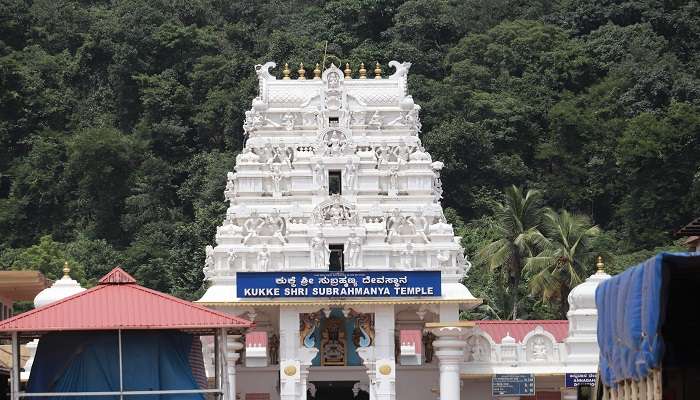
Lapped amidst dense luxurious greenery of Sahyadri mountain range and on the foothill of Kumaraparvatha, Kukke Subramanya Temple stands as a beacon of spiritual solace and divine grace. With the roots tracing back to mythological times, perched on the banks of the ever-flowing Kumaradhara, this powerful Naga Kshetra is the abode of the Lord Karthikeya. Kukke Subrahmanya, also known as Kukki or Kukkipattana, is a part of Parashurama Kshethra, Mangalore, Karnataka. This revered temple is enveloped by lush green foliage, which portrays an eternal bond between humanity and the serpent clan.
History Of Kukke Subramanya Temple
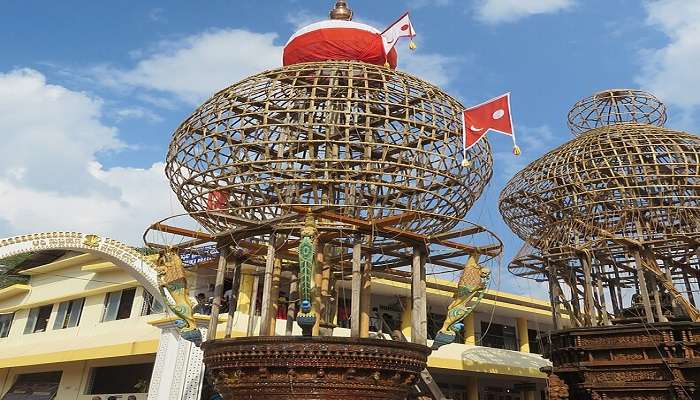
According to the legendary Skanda Purana, Garuda, unhappy with his mother Vinata’s enslavement due to Kadru’s deceit, harboured anger towards the Nagas. After freeing his mother from slavery, he unleashes fury upon the serpent clan. To escape from the claws of Garuda, Vasuki entered a cave (kukki) in the forest and started meditating to please Lord Shiva. Impressed with Vasuki’s untethered faith, Lord Shiva assures him that he’ll forever stay under the protection of his second son, Karthikeya.
After the battle, Lord Karthikeya, his elder brother Lord Ganesha & army, and the asura rulers, namely Taraka & Padmasura, came to the forest of Sahyadri (now Western Ghats). There, he was received by Indra and his followers. Pleased to hear about the episodes of bravery, Indra sought the acceptance of Lord Subramanya to marry his daughter, Deva Sena. On the auspicious day of ‘Margasira Shuddha Shasti’, Lord Subramanya married DevaSena, followed by the coronation ceremony on Kumara Parvatha.
Kumara Dhara
All the devotees must dip in the waters of Kumara Dhara or sprinkle the sacred water on their heads. The holy waters of these rivers are believed to possess healing powers to treat different skin ailments.
Suggested Read: Places To Visit Near Kukke
Garbhalayam Of Kukke Subramanya Temple
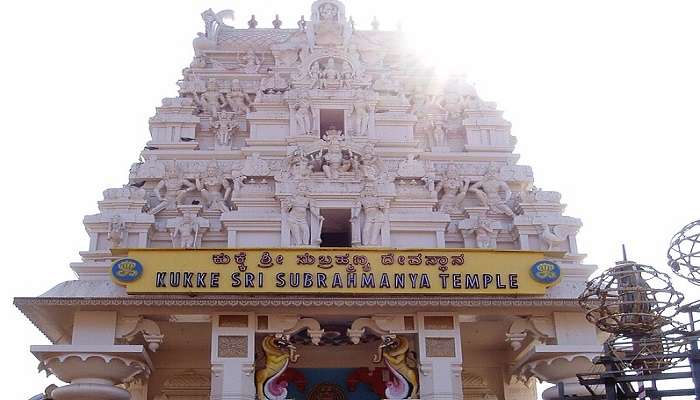
It is embellished with intricate carvings and different deity sculptures. The main idol of the temple can be categorised into three levels. The bottommost part is the hooded Anantha, and the top is the Kumaraswamy or Lord Subramanya, riding cheerfully on his peacock vehicle. In the middle, we can observe Vasuki taking refuge.
Entry to the main temple chamber or Garbhalayam is restricted to the public. Only the chief priests perform pujas inside. In connection with this, a mysterious and interesting belief prevalent to date is that the Serpent King Vasuki emits poisonous vapours in the process of exhalation. When in close proximity to the Garbha Griha, these poisonous vapours are considered to cause health problems. So, devotees are encouraged to stand safely, i.e., near the Garuda Stambha. The Silver-cladded Garuda Stambha is said to nullify/ neutralise the effects of the toxic vapours emanating from the idol of Vasuki.
Kukke Subramanya Temple: Popular Pooja Details
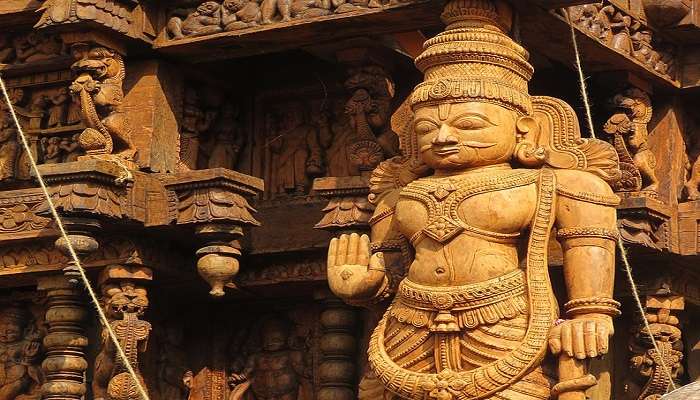
Amidst the tapestry of devotion, priests stand as the guards of tradition and carry out the wishes of the faithful devotees. Apart from popular rituals like Sarpa Samskara and Ashlesha Bali, the priests also carry out Archana, Abhisheka, Dolotsavam, Tulabhara, etc., on request for the six-headed Lord Shanmukha.
Sarpa samskara Pooja with Nagaprathishta
It is one of the most popular and famous poojas performed in the temple. It is believed to bring relief from health issues and fertility issues. This pooja is also suggested for unmarried people to remove doshas from their birth charts and look for good wedding prospects.
Who should perform the ritual?
According to beliefs, this pooja can be carried out by someone who may have any generational serpent-related curses, knowingly/unknowingly killed the snakes or caused harm to snakes, or may have removed their anthill in the site before constructing a house.
The pooja spans over two days. Devotees who are a part of this pooja must stay in the accommodation near the temple, have food provided by the temple authorities and strictly follow the simple rules of the ritual as told by the priest. Only men can perform the pooja, or else the priest will perform the ritual.
| Pooja | Timing | Cost |
| Sarpa Samskara Pooja with Nagaprathishta | 6.00 am to 8.00 am NagaPrathishta: 12.00 pm |
INR. 4200 |
Ashlesha Bali:
| Pooja | Timing | Cost |
| Ashlesha Bali | Morning: 7.00 am / 9.00 am
Evening: 5.00 pm |
INR. 400 |
As the name suggests, this ritual is performed on the days of Ashlesha star in the temple courtyard. This pooja is performed to negate all the negative effects of Rahu and serpent-related doshas.
Suggested Read: Places To Visit In Coorg
Kukke Subramanya Temple Pooja Timings

The temple’s main doors open at 5.00 am and close around 8.30 pm. Here’s a detailed list of timings of morning & evening routines:
Morning Routine:
| Temple Opens with Govu Pooja | 5.00 am |
| Ushakala pooja | 5.30 am to 6.00 am |
| Sevas by devotees | 6.30 am to 10.00 am |
| Afternoon (Madhyanna) Pooja including different sevas like Archanas, Abhishekam, Maha Naivedyam & Mangal Aarti | 10.00 am to 12.15 pm (followed by Teertha, Prasada & free meal distribution Anna Prasadam to devotees up till 2.00 pm) |
| Temple closure (Window for rest) | At 1.30 pm |
Evening Routine:
| Temple Opening for the evening session | 3.30 pm |
| Evening Mangal Aarti | 3.30 pm to 6.00 pm |
| Nisha Pooja & Maha Mangagalaarti | 6.00 pm to 7.45 pm (followed by Teertha & Prasada distribution till 8.30 pm) |
| Closing of temple doors | At 8.30 pm |
| Anna Prasadam (Free dinner) | 7.30 pm to 9.30 pm |
Note: The timings of the temples are subject to change on festivals & special occasions.
Kukke Subrahmanya Temple: Nearby Tourist Spots
Many other significant temples are near the Kukke Subrahmanya Temple, each with a unique history and spiritual significance.
1. Adi Subramanya Temple
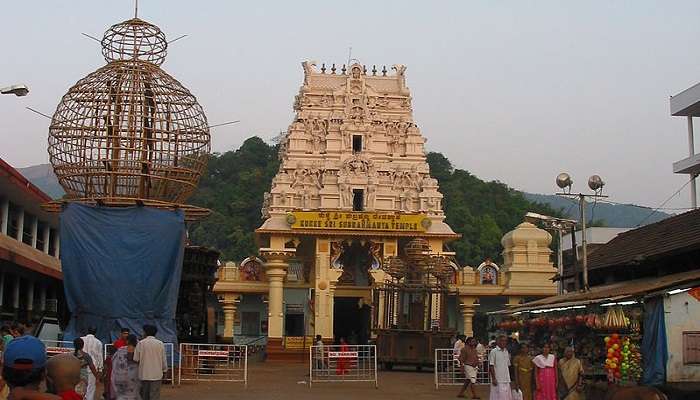
Dated roughly 5000 years ago, the popular belief among the locals and devotees is that a pilgrimage to Kukke Subramanya is incomplete without visiting the Adi Subramanya Temple. This temple is roughly half a kilometre away from the main temple. The main sanctum houses Lord Subramanya, who is manifested as an ancient Anthill. It is the belief of the devotees that this is the original place where Vasuki received divine blessings, sought his solace, finding refuge in the benevolent grace of Lord Kumaraswamy.
Suggested Read: 15 Top Hill Stations In Karnataka
2. Samputa Narasimha Temple
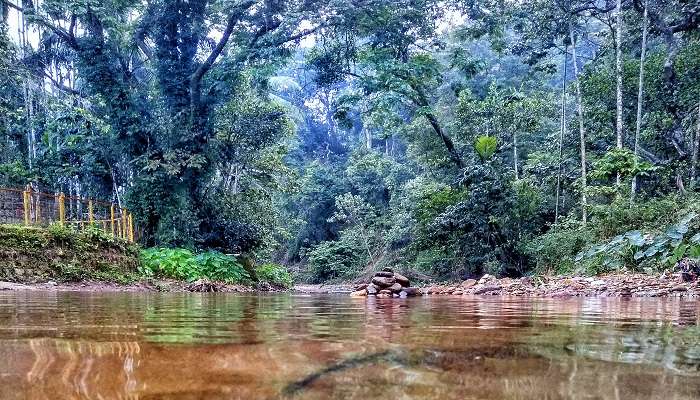
According to the life history of Madhwacharya, on his expedition to the Himalayas visited Maharishi Vedavyas. The Maharishi entrusted Madhwacharya with 8 Shaligrams and a powerful Narasimha Shila. Out of which one Narasimha Shaligram is consecrated in the Samputi Narasimha Temple. And the rest are securely preserved in an unbreakable box (Abhedya Samputi) which is taken care of by the lineage of Madhwacharya. Hence the name Samputi Narasimha.
3. Hosaligamma Temple
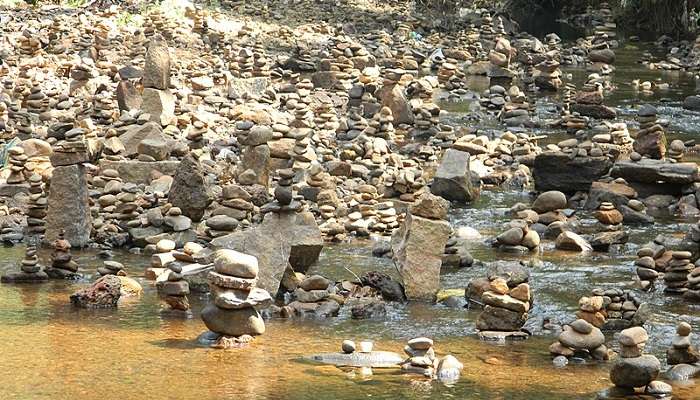
Image Credit: Soorajna for Wikimedia Commons
To the south of Kukke Subramanya temple is the Hosaligamma temple. The presiding deity is a local goddess. It is a very ancient & typical Tulunadu shrine depicting the ‘Bhootha’ culture of the place.
How To Reach
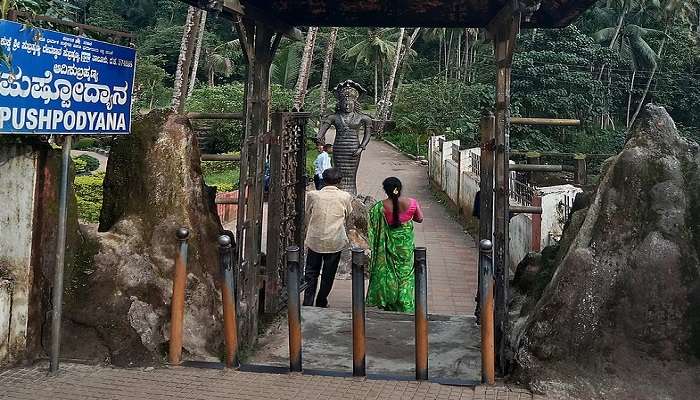
By Road: Road connectivity to Kukke is good. Karnataka State Transport runs regular buses to Kukke from all the popular cities & towns. Kukke is roughly about 280 km from Bangalore & 105 km from Mangalore.
By Air: Mangalore International Airport is the nearest airport. It takes 2 hours to reach Kukke by cab.
By Rail: The temple is roughly 12.5 km away from the Subramanya Road railway station (Station Code: SBHR). You can take a jeep or an auto-rickshaw to reach the village of Kukke.
Further Read: Tourist Places In South India During Summer
Further Read: Tourist Places In South India During Summer
Kukke Subramanya temple visit is a journey of spiritual awakening. If this Kukke Subramanya Temple guide motivates you to plan a visit, here are some of the best plans for a trip to Karnataka. Visit the Kukke Subramanya temple and immerse in his divine grace!
For our editorial codes of conduct and copyright disclaimer, please click here.
Cover Image Source: Shutterstock
Frequently Asked Questions About Kukke Subramanya Temple
What is the best time to visit Kukke Subramanya Temple?
Winters (September to March) are the best time to visit the temple.
Can we book tickets for the seva/pooja online?
All the tickets except for Sarpa Samskara with Nagapratistha can be obtained from the temple counter in Kukke.
What is the dress code to be followed
Men must wear a dhoti when entering the temple. Shirts, trousers, vests and caps are not allowed. Women can choose to wear Saree or Salwar Kameez as per their preference.
Can one arrange for a private ceremony at Kukke Subramanya?
Namakarana (Naming Ceremony), Annaprashana, Ear piercing, Hair Tonsuring (Chavla – first hair cut) for kids, Upanayanam (Thread Ceremony), Sathyanarayana Pooja etc., are arranged by the temple.
What festivals are celebrated at Kukke Subramanya temple?
Apart from the major Hindu festivals, the Hindu month of Karthika is very special to Lord Shanmukha. Celebrations like Lakshadeepotsava, Chandramandalotsava, Radhostava and Urulu seva are facilitated in grandeur.
People Also Read:
Temples in South India Temples In India Temples In Karnataka
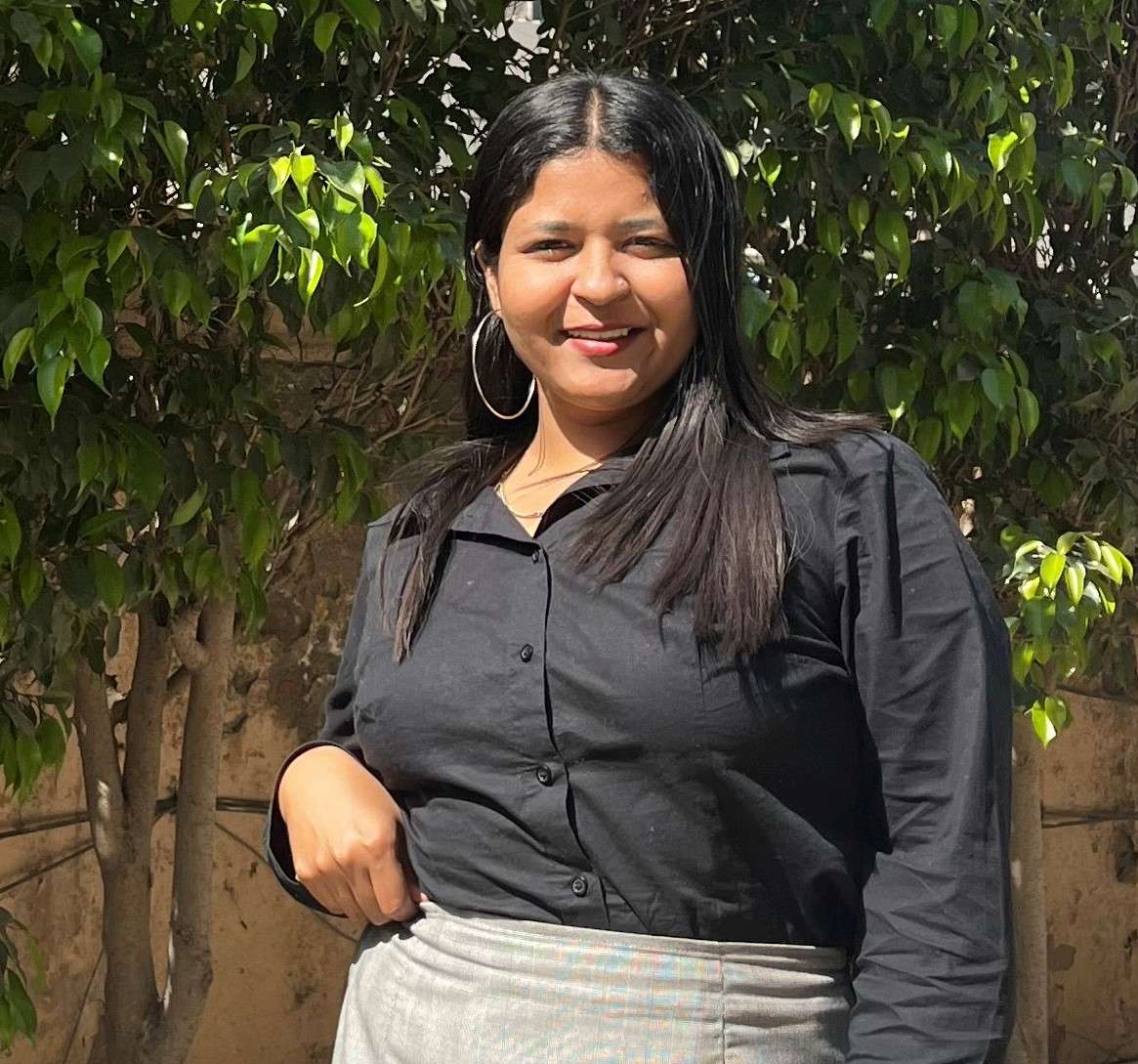
Embrace the essence of surreal places around the world through perfect narratives with a touch of imagination. As a content writer, I weave my ideas and words together to create a vivid picture of alluring destinations. Embark on limitless adventures as you read thrilling travel stories.











